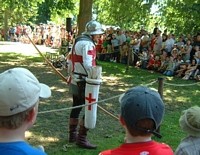| In early August 2004, we drove up to
see Warwick Castle and Kenilworth Castle. |
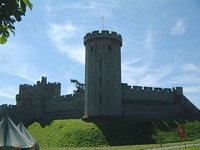 |
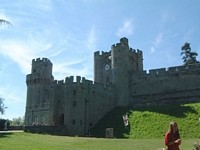 |
 |
| A view of Guy's tower and the barbican from
the outside. Guy’s Tower was built in the 14th century. It is
twelve-sided, stands 39 meters high and has five stories. (79kb)
|
The barbican, which had a drawbridge,
reaches out into the dry ditch to give the gatehouse more
protection. It was completed in the 14th century. (83kb) |
Debbie, in front of the barbican.
(117kb) |
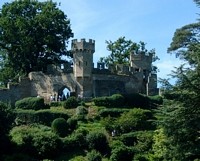 |
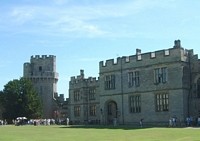 |
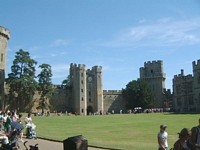 |
| First built in 1068 on the orders of William
the Conqueror, the mound at the back of the current castle formed the most
important part of the Norman castle's defense system. (182kb) |
The Great Hall, as it stands today, was
first constructed in the 14th century. In the background is
"Caesar's tower", built on the orders of Thomas de
Beauchamp. It has an irregular quatrefoil or cloverleaf shape and
rises 44.8 meters from the solid rock just above the river level. It has
three stories, not including the dungeon. These are topped by a platform
with a crenellated and machicolated parapet. (95kb)
|
The castle grounds from the inside.
The twin towers are the inside of the barbican. (83kb) |
 |
|
|
| For nearly 600 years the Mill and Engine
House used the power of the River Avon to grind grain. A century ago that
same 'hydro' power was harnessed by the Castle's engine house to generate
electricity for the household. (189kb)
|
|
|
| Downstream from the
mill, a bridge takes you across the Avon and onto an island. The day
we visited, a grand joust was taking place. |
|
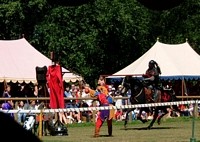
|
 |
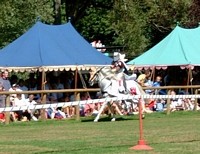 |
| The jester, holding the quintain weight, get
ready to play a trick on the black knight. (145kb)
|
The yellow knight charging the quintain. (101kb)
|
The white knight charging the quintain.
(69kb)
|
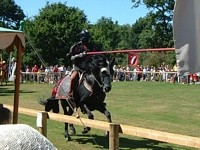 |
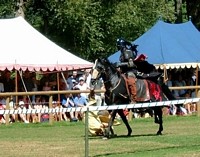 |
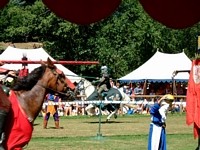 |
| A nice shot of the black knight as he
charges the near quintain. (84kb) |
The black knight running over a servant who
gets in the way. (85kb) |
The green knight (on the far side) charging
the quintain while the red knight's horse is just entering the picture at
the near quintain. (175kb)
|
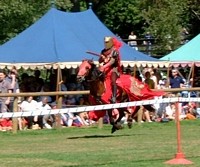 |
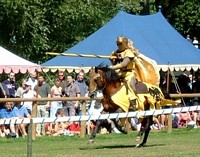 |
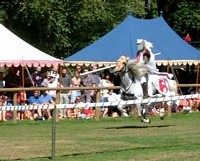 |
| The red knight charging the far quintain.
(51kb)
|
The yellow knight. (59kb)
|
The white knights... (69kb)
|
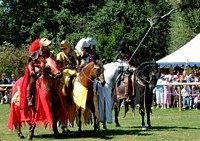 |
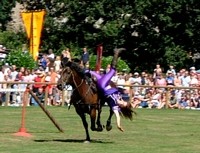 |
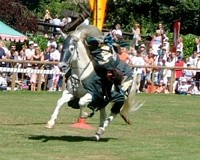 |
| Four of the knights, waiting on the fifth
one. (196kb) |
The "princess" doing a riding
demonstration. (57kb) |
The green knight trying to match the
princess's demonstration. (45kb)
|
| Underneath the Great Hall, was an
exhibit of the "Earl of Warwick, Kingmaker" which had some
pretty cool exhibits especially this one of an arming
coat/jupon. |
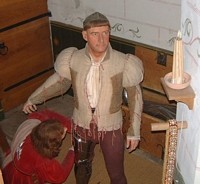 |
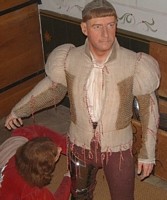 |
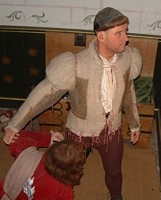 |
| A servant arming the Earl. (105kb) |
A closer view. (145kb) |
A side view of the jupon.
(118kb) |
Kenilworth Castle has been intimately linked with some of the most
important names in English history. Today, with its impressive Norman
keep, Tudor gardens and John of Gaunt’s Great Hall, it is among the
largest castle ruins in England.
The first castle at Kenilworth was built some 50 years after the Norman
Conquest. Henry II took over the castle 50 years later, to counter an
attack from his son’s rebel army. It was then radically extended by King
John, who also transformed the mere (great lake) into one of the castle’s
most glorious features. In 1253, Henry III gave the castle to Simon de
Montfort. The de Montforts turned against the Crown in the Barons’ War
of 1266 and the castle was besieged. They held out for almost nine months,
until disease took its toll and the de Montforts surrendered. Later,
Edward II was briefly imprisoned here before being taken to Berkeley
Castle and hideously murdered in 1326. Henry V spent time here after
defeating the French at the Battle of Agincourt in 1415. He built himself
a banqueting house on the other side of the lake.
|
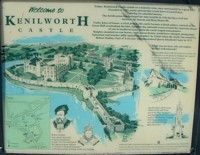 |
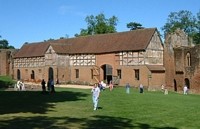 |
 |
| The info sign on Kenilworth
castle. (124kb) |
The stable block was built by
Robert Dudley, Earl of Leicester, befitting his position as Master of the
Queen’s Horse. (95kb) |
A model of Kenilworth, showing
the causeway/tiltyard and the great "mere" (lake) around the
castle. (101kb)
|
 |
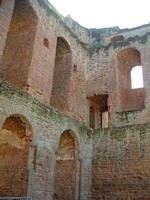 |
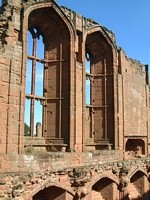 |
| After Geoffrey de Clinton
established Kenilworth Castle in the 1120s, he began building the stone
keep, the defensive core of the fortress. Debbie in the keep. (136kb)
|
In 1266 it withstood the longest
siege in medieval times, lasting nine cruel months. (124kb) |
Remains of windows in the great
hall. (161kb) |
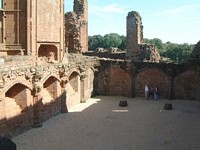 |
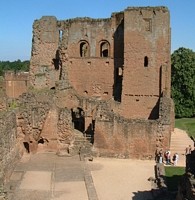 |
 |
| Between 1361 and 1399, John of
Gaunt owned the castle and rebuilt the state and reception rooms in
magnificent style. At the centre of his design was the Great Hall, used
for entertaining, feasting and holding audiences. This shows the
undercroft of the great hall. (131kb)
|
Looking at the keep, from the
end of the great hall, and across the medieval kitchens. (192kb) |
Another shot of the windows in
the great hall. (135kb) |
 |
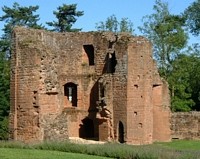 |
 |
| Some neat tracery. (175kb) |
The remains of an outer tower
building. (184kb)
|
The interior of the stable block
showing the roof supports. (163kb) |
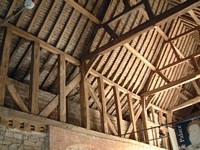 |
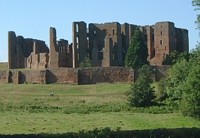 |
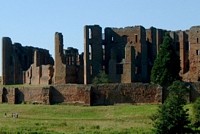 |
| The shows the mortise and tenon
joinery of the stable block roof (159kb) |
Looking from across the mere,
next to the causeway (hidden by the trees on the right). (110kb)
|
Another shot from across the
mere, but zoomed in some. (110kb) |
